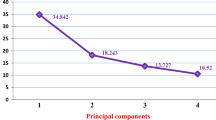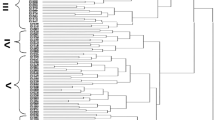Summary
Two subspecies were recognized byMuratova inV. faba: faba andpaucijuga. Paucijuga is hardly represented in present collections, but some of its accessions present a very primitive aspect, resembling otherVicia species, both because of their growing habit (very small height, many branches, no principal stem, etc.) and their genetic architecture. But some other characteristics (indehiscent pods, extreme self-fertility) suggest some degree of domestication.
Principal Component Analysis using forms belonging to the twoMuratova's subspecies showed that some key characteristics in the taxonomy ofV. faba have only a secondary discriminatory value. The best clustering was obtained using seed size, a fact suggesting that the evolution of the known cultivated forms has occurred under domestication and that main seeds were the main objective in selection. Genetic studies indicate that these taxonomic characters (number of leaflets per leaf, thickness/length of the seed) are under polygenic control.
These primitive forms cross readily with all the other botanical types offaba beans. In particular, crosses with the most extreme forms of modern cultivals (belonging to the major group) are perfectly possible.
As a conclusion, only one subspecies has to be recognized for the cultivated forms (the only known one up to date) offaba bean:Vicia faba faba. Thepaucijuga forms described here probably are those most similar to the wild types.
Zusammenfassung
Bei Vicia faba werden vonMuratova zwei Subspecies unterschieden:faba undpaucijuga. Paucijuga ist in den derzeitigen Kollektionen kaum vertreten; einige dieser Proben vermitteln aber auf Grund ihrer Wuchsform (sehr geringe Höhe, starke Verzweigung, fehlender Hauptsproß u. a.) und ihrer genetischen Beschaffenheit einen sehr primitiven Eindruck. Einige andere Merkmale (nichtplatzende Hülsen, extreme Selbstfertilität) weisen aber auf ein gewisses Maß der Domestikation hin.
Die Hauptkomponenten-Analyse bei Formen, die zu beiden vonMuratova unterschiedenen Unterarten gehören, zeigte, daß einige Schlüssel-Merkmale in der Taxonomie vonVicia faba nur sekundäre Bedeutung für die Unterscheidung haben. Die beste Gruppierung wurde bei Verwendung der Samengröße erhalten, eine Tatsache, die einen Hinweis darauf gibt, daß sich die Evolution der bekannten kultivierten Formen unter Domestikationsbedingungen vollzog und daß vor allem die Samen den Hauptgegenstand der Selektion bildeten. Genetische Untersuchungen zeigen, daß diese taxonomischen Merkmale (Anzahl der Blättchen je Blatt, Dicke/Länge der Samen) polygen bedingt sind.
Diese Primitiv-Formen kreuzen sich leicht mit allen anderen botanischen Typen derfaba-Bohnen. Insbesondere sind Kreuzungen mit extremen Formen der modernen Sorten (die zurmajor- Grappe gehören) durchaus möglich.
Daraus ergibt sich die Schlußfolgerung, daß die kultivierten Formen derfaba-Bohne nur zu einer (z. Zt. der einzigen) Unterart zu rechnen sind:Vicia faba faba. Die hier beschriebenenpaucijuga-Formen haben wahrscheinlich die größte Ähnlichkeit mit den Wildtypen.
Краткое содержание
муратова различает у Vicia faba два подвида: faba и paucijuga. Последний почти не представлен в современных коллек циях; некоторые образцы ssp. paucijuga производят впечатле ние очень примитивны х форм по их габитусу (низкорослость, сильн ая ветвистость, отсут ствуе главного стебля и пр.) и генетической консти туции. Однако другие п ризнаки (невскрывающийся боб, полная самофертильн ость) указывают на изв естную степень одомашненно сти.
Анализ главных компо нентов у форм, принадл ежащих к обоим подвидам муратовой показал, чт о некоторые ключевые признаки в таксономии Vicia faba имеют только вторичн ое значение для их различаемоcти. Наибол ее удачная группировка получилась на основа нии величины семян. Этот факт указывает на то, что эв олюция известных кул ьтурных форм протекала в условиях одомашненн ости и, что отбор вëлся, в первую очередь, по признакам семян. Генетические и сследования показал и, что такие таксономические при знаки как отношение толщин ы к длине семени, число листочков в сложном листе — обусловлены п олигенно.
Описанные примитивн ые формы легко скрещи ваются со всеми прочими типами конских бобов. В частности — вполне в озможны скрещивания с самыми современными сортам и, принадлежащими к гр уппе major.
Можно сделать заключ ение, что культурные ф ормы конских бобов принад лежат только к одному совре менному подвиду Vicia faba faba. Оп исанные здесь формы paucijuga, очевидн о, имеют наибольшее сх одство с исходным дукорастущим типом.
Similar content being viewed by others
Literature
Bueno, M. A., 1976: Citotaxonomía y cariología en el géneroVicia. - Ph. D. Thesis, Facultad de Biología, Universidad Complutense, Madrid.
Chooi, W. Y., 1971: Variation in nuclear DNA content in the genusVicia. - Genetics68, 195–211.
Cubero, J. I., 1973: Evolutionary trends inVicia faba. - Theor. Appl. Genetics43: 59–65.
—, 1974: On the evolution ofVicia faba. - Theor. Appl. Genetics45, 47–51.
—, 1976: Herencia de caracteres cuantitativos enVicia faba L. - Servicio de Publicaciones INIA, 113 pp. Madrid.
Hanelt, P., 1972: Die intraspezifische Variabilität vonVicia faba L. und ihre Gliederung. - Die Kulturpflanze20, 75–128.
Harlan, J. R., 1975: Crops and man. - American Society of Agronomy, Madison.
—, andJ. M. J. De Wet, 1971: Toward a rational classification of cultivated plants. - Taxon20, 509–517.
Ladizinsky, G., 1975: Seed protein electrophoresis of the wild and cultivated species of sectionFaba ofVicia. - Euphytica24, 785–788.
Martin, A., 1976: Genética de los componentes del rendimiento enVicia faba. - Ph. D. Thesis. Escuela Técnica Superior de Ingenieros Agrónomos. Córdoba.
-, and J. I.Cubero, 1978: Inheritance of quantitative characters inVicia faba, in Some current research onVicia faba in Western Europe, ed. by the European Communities.
Moreno, M. T. andA. Martinez., 1980: The divided world ofVicia faba. - Fabis2: 18.
Muratova, V., 1931: Common beans (Vicia faba L.). - Bulletin of Applied Botany of Genetics and Plant Breeding, Supplement50, Leningrad.
Author information
Authors and Affiliations
Rights and permissions
About this article
Cite this article
Cubero, J.I., Suso, M.J. Primitive and modern forms ofVicia faba . Die Kulturpflanze 29, 137–145 (1981). https://doi.org/10.1007/BF02014744
Issue Date:
DOI: https://doi.org/10.1007/BF02014744




